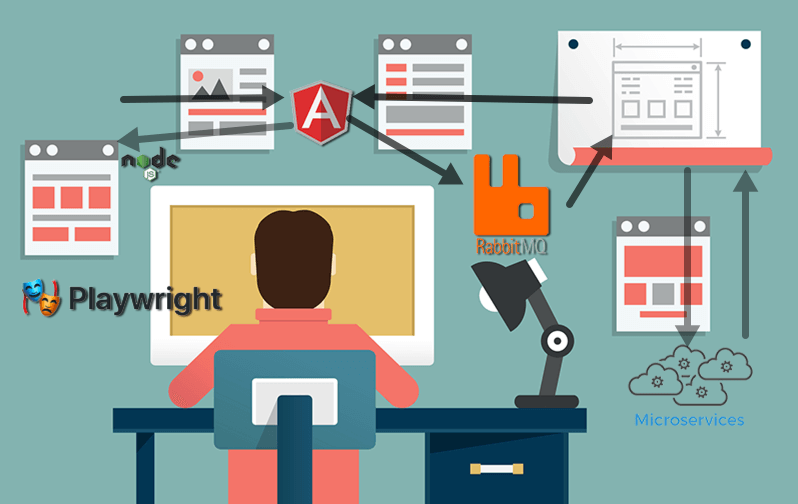What is Headless testing?
As the web evolves, new technologies are born, and others fall into obscurity. Headless browser testing is one of those technologies that has been on the rise in recent years.
But what is this headless testing “browsing”?
It actually is what it sounds like.
Headless testing is when you run a UI-based browser test without showing the browser UI. It's running a test or running a script against a browser, but without the browser, UI starts up.
Why would you want to use headless browsers? There are a lot of pros and cons to following this approach. Using a headless browser might not be very helpful for browsing the Web, but for automating tasks and tests, it’s awesome.
INDEX
Check out all our free automation courses
Why Should You Care About Testing with a Headless Browser?
Follow the money is such a cliché, but it’s a key indicator of what I think is a real trend and something I should pay attention to.
For example, when I originally wrote this post (FYI: I update it frequently) Sauce Labs had just came out with a new service called Sauce Headless, a cloud-based headless testing solution.
I know the folks at Sauce are smart folks.
They don’t develop anything unless they’ve gotten feedback from their users that it’s needed functionality.
I’m sure they will not be alone with their focus on headless testing.
Headless browser testing is a shift-left design thinking that is important for software QA.
This means the tests are automated and run in the browser without the need for any user interaction.
As we shift more and more left in our software development lifecycle, we need to give feedback to our developers faster and faster.
One way to do this is using some quick checks leveraging a headless browser.
Automation in Software Production
If you know me at all, you also know that I’m very automation inclusive.
To me, it's not just about automation testing.
It's anything that you can automate to save someone time or effort in any part of the software delivery lifecycle–whether it's developing, quality, testing, DevOps, or installation; I would refer to any of these as automation. And headless browsers are something you can actually utilize for a lot of these efforts.
Headless browser testing is the process of testing an application or website without a human user watching.
This technique has pros and cons that will depend on your particular project.
PROs For Headless Testing
Headless Browsers are Faster than Real Browsers
One definite “pro” of headless browsers is that they are typically faster than real browsers; the reason being that since you aren’t starting up a browser GUI you can bypass all the time a real browser takes to load CSS, JavaScript, and open and render HTML.
I have to admit, although, that it's not exactly like night and day. But you will typically see a 2x to 15x faster performance when using a headless browser.
So if performance is critical for you, headless browsers may be a way to go.
Join the Guild Community(Free)
Headless Browser Scraping
Another advantage of headless browsers is that they can be used to scrape websites. To do this, you don't necessarily want to have to manually start up a website, however. You can go to it headlessly and just scrape the HTML.
You don't need to render a full browser to do that.
For example, say your job needs some data on sports statistics or to compare prices between different sites.
Since it's just data you’re looking for, it doesn’t make sense to start up a full instance of a browser; it's just extra overhead–and sometimes, the less overhead you have, the quicker you'll get results back.
It may not necessarily be a test, and that's okay. Again, you want to leverage the right tools to do the right things.
I also think that headless browser scraping is not leveraged by many testers – and that's a shame.
So if you want to do some website scraping to help you with a test, later on, you won't necessarily need the overhead of starting a full-blown browser; you can utilize headless browsers to obtain that functionality for you.
Save Your Developers' Time
I’m aware that a lot of developers use a headless browser for unit testing code changes for their websites and mobile apps. Being able to do all this from a command line without having to manually refresh or start a browser saves them lots and effort.
For example, Rob Friesel, author of the PhantomJS CookBook, in a TestTalks interview, explained how his developers use the headless browser PhantomJS:
“Although PhantomJs in itself is not a test framework, it’s a really good canary in a coal mine to give you some confidence; if your tests are passing, you can have a high degree of confidence that your code is ok.”

Monitor Performance With Headless Browser Scripts
Another common one is to use a headless browser script to monitor network application performance.
Some even use it to automate the rendering and screen capturing of their website images to perform layout checks in an automated fashion.
I think these are some of the reasons why Google has also developed a new headless Chrome API called Puppeteer that was designed to handle many of these developer use cases.
Cons of this Approach
While headless browser testing offers numerous benefits, it's important to consider some potential drawbacks:
1. Limited Visual Feedback: Headless testing runs without a visible user interface, which means you don't have real-time visual feedback during test execution. This can make it challenging to identify and diagnose issues related to layout, styling, or visual elements. Debugging visual discrepancies may require additional effort and reliance on screenshots or video recordings.
2. Complexity in Setting Up Test Environment: Configuring a headless testing environment can be more complex compared to regular browser testing. It may require additional setup and configuration, such as installing headless browsers, configuring CI/CD pipelines, and ensuring compatibility with your testing framework. This complexity can be especially challenging for teams new to headless testing.
3. Lack of Real User Interaction: Headless testing simulates user actions programmatically, but it doesn't fully replicate real user interactions. It may not account for certain user behaviors, such as hovering, double-clicking, or complex gestures. Some user-specific scenarios or edge cases might be missed during headless testing, requiring additional manual testing.
4. Limited Browser Support: While headless testing is supported by major browsers like Chrome and Firefox, some browsers may have limited or no support for headless mode. This can be a drawback if your application needs to be tested on specific browser versions or less common browsers. It's important to check the compatibility of your chosen headless testing tool with the browsers you need to test.
5. Potential for Flaky Tests: Headless tests can sometimes be prone to flakiness, meaning tests may intermittently fail due to timing issues, race conditions, or inconsistent page loads. Flaky tests can be frustrating and time-consuming to debug and stabilize. It requires careful design of test scripts, proper waiting mechanisms, and handling of asynchronous behavior to mitigate flakiness.
6. Limited Testing of Browser-Specific Features: Headless testing may not fully support testing browser-specific features or extensions. If your application relies on browser-specific functionalities or integrates with browser extensions, headless testing might not provide comprehensive coverage. Testing such scenarios may require additional tools or manual testing.
7. Maintenance and Updating Test Scripts: As your application evolves, you'll need to maintain and update your headless test scripts to keep up with changes in the UI, functionality, or APIs. This maintenance effort can be time-consuming, especially if you have a large test suite. It requires ongoing effort to ensure the test scripts remain reliable and relevant.
8. Debugging Challenges: Debugging headless tests can be more challenging compared to regular browser testing. Since the tests run without a visible interface, identifying the exact point of failure or understanding the state of the application during a test failure may require additional debugging techniques, such as logging, screenshots, or video recordings.
Despite these drawbacks, the benefits of headless testing often outweigh the limitations.
Many of these challenges can be mitigated through careful planning, robust test design, and the use of appropriate tools and frameworks. It's essential to evaluate your testing requirements and consider the trade-offs before adopting headless testing in your development workflow.
Other Headless Browser Testing Ideas
Besides the one we’ve already covered, here are some other uses for headless browsers that I’ve run across:
- Run tests on a machine without a display
- Setup Data
- Performance Testing
- Testing SSL
- Simulating multiple browsers on a single machine
- Running tests on a headless system like Linux OS without GUI
- Retrieve and render PDFs
- Layout testing – since headless browsers render and interpret CSS & HTML like a real browser, you can use them to test style elements.
Examples of When You Might NOT Want to Use a Headless Browser
Of course, there are a number of reasons why you may wish to use a real browser as opposed to a headless browser. For instance:
- You need to mimic real users
- You need to visually see the test run
- If you need to do lots of debugging, headless debugging can be difficult.
Popular Headless Browsers
- Google Puppeteer- The Headless Browser Puppeteer is a Node library. It gives you a high-level API to control headless Chrome or Chromium over the DevTools Protocol. It also can also be tweaked to use full (non-headless) Chrome or Chromium.
- Google Chrome since version 59
- Firefox versions 55 & 56
- PhantomJS –is a headless WebKit scriptable with a JavaScript API. It has fast and native support for various web standards: DOM handling, CSS selector, JSON, Canvas, and SVG. *This is no longer being maintained. Because of this, you might want to avoid it.
- HtmlUnit –is a “GUI-Less browser for Java programs.” It models HTML documents and provides an API that allows you to invoke pages, fill out forms, click links, etc.… just like you do in your “normal” browser.
- Splinter – Splinter is a headless browser Python-centric option. It's open-sourced and is used for testing web applications using Python. For example, you can use it to automate browser actions, such as visiting URLs and interacting with their items.
- jBrowserDriver – A programmable, embeddable web browser driver compatible with the Selenium WebDriver spec — headless, WebKit-based, pure Java
When Should Headless Browser Testing be used?
So when should you use headless browsing for your testing? As you can see, it depends on your testing goals.
People on the left will often say, “Never use a headless browser. A real user would never use it, so why should you?”
Meanwhile, folks on the right will say, “You should always use headless browsers because they’re always faster, and faster is always better.”
As we well know, however, it’s not always one versus the other, but rather a matter of selecting the right tool for the rights task depending on the situation.
Remember–use the right tool for the job and always ask yourself how it will affect the end users and what the goal(s) of your test is when deciding between the two approaches.
That being said here are the most popular scenarios mentioned in my automation testing conferences and testing podcasts to ensure efficient and reliable testing of web applications:
1. Continuous Integration and Deployment (CI/CD) Pipelines: Headless browser testing is ideal for integration into CI/CD pipelines. It allows automated tests to run without requiring a graphical user interface, making it suitable for server environments. By including headless tests in your CI/CD workflow, you can catch regressions early, ensure code quality, and enable faster feedback loops.
2. Automated Regression Testing: Headless browser testing is highly beneficial for automated regression testing. You can create a comprehensive suite of headless tests that cover critical functionality and user flows. These tests can be run automatically whenever changes are made to the application, ensuring that existing features continue to work as expected.
3. Performance Testing: Headless browsers provide a lightweight and fast execution environment, making them suitable for performance testing. You can simulate multiple users accessing your application concurrently using headless tests, measure response times, and identify performance bottlenecks. This helps in optimizing your application's performance and scalability.
4. Cross-Browser Compatibility Testing: Headless testing allows you to test your application across different browser versions and platforms efficiently. By running headless tests on various browser configurations, you can ensure your application renders and functions correctly on all supported browsers, improving cross-browser compatibility.
5. Integration with Browser Automation Tools: Headless browser testing integrates seamlessly with popular browser automation tools like Cypress, Playwright, and Puppeteer. These tools provide APIs and libraries specifically designed for headless testing, enabling you to write and execute tests efficiently. They offer features like automatic waiting, assertions, and debugging capabilities, making headless testing more robust and maintainable.
6. Headless Testing in Cloud Environments: Headless testing is particularly useful when running tests in cloud environments or containerized setups. It eliminates the need for a physical display or GUI, making it easier to scale and parallelize test execution across multiple machines or containers. This enables faster test execution and reduces infrastructure costs.
7. Testing Backend Functionality: Headless browser testing is not limited to testing the user interface. It can also be used to test backend functionality by simulating user actions and verifying the expected responses. This allows you to validate the end-to-end behavior of your application, including API calls, database interactions, and server-side processing.
8. Continuous Testing: Headless browser testing supports continuous testing practices by enabling tests to be run frequently and automatically. By integrating headless tests into your development workflow, you can catch bugs early, reduce the risk of regressions, and ensure the stability and quality of your application throughout the development lifecycle.
Headless browser testing should be used when you require automated, efficient, and scalable testing of web applications.
It is particularly valuable in CI/CD pipelines, regression testing, performance testing, cross-browser compatibility testing, and integration with browser automation tools.
Headless testing allows you to run tests quickly, without the need for a graphical interface, making it ideal for continuous testing and ensuring the quality of your web applications.

How can Playwright be set up for headless browser testing?
Based on my interviews with many automation experts on my TestGuild Automation Podcast Playwright can be easily set up for headless browser testing in a few ways:
1. By default, Playwright runs tests in headless mode. So you can simply run your Playwright tests from the command line using a command like "npx playwright test" and it will execute the tests headlessly without opening a visible browser window.
2. If you want to run Playwright tests headlessly from code, you can specify headless mode when launching the browser. For example:
const browser = await chromium.launch({ headless: true });
This will run Chromium in headless mode for the test.
3. Playwright also makes it easy to run tests headlessly in CI/CD pipelines. You can simply install Playwright and run your tests from the CI script or yaml file. Playwright will automatically execute the tests in headless mode in the CI environment.
4. For debugging, you can use the “npx playwright test –debug” command and Playwright will open the Playwright Inspector which allows you to step through the test and see the browser execution, even when running headlessly.
5. Playwright's cross-browser support also extends to headless mode – you can run your tests headlessly across Chromium, Firefox and WebKit.
Playwright aims to make headless browser testing simple by defaulting to headless, providing easy configuration options, integrating seamlessly with CI/CD, and offering debugging tools that work with headless mode. This allows developers and testers to efficiently run browser tests in headless mode.
How can Cypress be set up for headless browser testing?
Based on numerous interviews with experts like Gleb Bahmutov i've found that Cypress can be set up for headless browser testing in a few ways:
1. Cypress has a headless run mode in addition to the headed/interactive mode. You can run Cypress tests headlessly using the cypress run command, as opposed to cypress open which opens the interactive test runner.
2. Even when running tests headlessly, Cypress will still generate screenshots on test failures and videos of the full test run by default. This provides useful debugging information even without the headed mode.
3. The presenter mentioned Cypress runs scheduled tests in headless mode on remote servers/VMs. This allows running the Cypress tests in CI/CD pipelines without needing a graphical interface.
4. When tests are running headlessly, the output and results are printed to the terminal/logs, including any test failures, screenshots and links to the videos.
5. So in summary, running `cypress run` instead of `cypress open`, having Cypress installed on remote CI machines, and leveraging the automatic screenshots and videos allows setting up effective headless testing with Cypress. The headless mode provides speed and efficiency for integrating Cypress tests into automated pipelines.
How can Headless Browser Testing be executed effectively?
Here is what the experts have to say about effectively executed headless testing of browsers and best practices:
1. Choose a reliable headless browser automation tool: Select a well-established and actively maintained tool like Cypress or Playwright that supports headless testing out-of-the-box. These tools provide APIs to control the browser programmatically without a user interface.
2. Configure your test environment for headless execution: Ensure your test environment, whether local or in a CI/CD pipeline, is set up to run the tests in headless mode. This typically involves using command line flags or configuration settings specific to your chosen tool.
3. Leverage built-in debugging features: Take advantage of the debugging capabilities provided by your headless testing tool. Cypress, for example, automatically generates screenshots on test failures and records videos of the entire test run, even in headless mode. These artifacts aid in troubleshooting and understanding test behavior.
4. Write stable and reliable test scripts: Follow best practices for writing resilient test scripts that handle asynchronous behavior, waits, and timeouts correctly. Use explicit waits and assertions to ensure the desired state is reached before proceeding with the test steps.
5. Implement proper error handling and logging: Include robust error handling mechanisms in your test scripts to gracefully handle exceptions and provide meaningful error messages. Capture and log relevant information for debugging purposes.
6. Utilize CI/CD integration: Integrate your headless tests into your continuous integration and deployment (CI/CD) pipeline. Configure your CI/CD system to trigger the headless tests automatically on code changes or at scheduled intervals. This ensures the tests are run consistently and frequently.
7. Monitor and analyze test results: Set up a centralized system to collect and analyze the test results generated by your headless tests. Use reporting and dashboarding tools to visualize test metrics, identify trends, and track the overall health of your test suite.
8. Optimize test execution speed: Implement techniques to optimize the execution speed of your headless tests. This may involve parallelizing test runs across multiple machines, optimizing test data setup and teardown, and minimizing unnecessary delays in test scripts.
9. Ensure cross-browser compatibility: While headless testing is often focused on a single browser, it's essential to validate your application's compatibility across different browsers. Consider running your headless tests against multiple browser versions and platforms to ensure wider coverage.
By following these best practices, you can effectively execute headless browser testing, enabling faster feedback loops, increased test coverage, and improved reliability of your web applications.
What frameworks are used for Headless Browser Testing?
As you have seen, there are many Frameworks commonly used for Headless Browser Testing, including Puppeteer, Selenium WebDriver, and Playwright. These tools provide:
- A set of APIs and capabilities for automating the testing of web applications in a headless browser environment.
- Enabling developers to perform tasks such as browser manipulation.
- Page interaction.
- Assertions.
By utilizing these frameworks, testers can achieve efficient and reliable testing processes while benefitting from features like cross-browser testing, parallel execution, and integration with continuous integration systems.






Thanks for this true differences.
“Although PhantomJs in itself is not a test framework, it’s a really good cannery in a coal mine…”
The phrase is “canary in a coal mine”. A small bird taken into underground mines (especially coal mines) as an early warning for noxious and deadly gasses.
Cannery is a place where stuff is put in cans.
HAHA – thanks Karl for pointing out the typo :) I’m a terrible speller
Thank for the info Joe,
But what about negative experience of using headless browser in testing?
For me, headles browser (PhantomJS) is taking longer than Chrome to execute test cases.
Html, JavaScript, images and CSS still has to be loaded by a headless browser.
True I think since real users user a real browser not a headless on if you just rely on headless browser for your verification test you could miss UI bugs
Re. Performance increases.
I am really interested in headless testing, but am wondering about the real gains in performance.
If I have a single page application that makes lots of client side API calls, rather than a server side generated HTML page, is the test still 1.5 to 2 times faster, or are we simply talking about browser interaction and rendering?
If my test bottleneck is API requests, then I assume headless does not address this?
PhantomJS was a pain when it was being maintained (not behaving like a real browser would in response to some Selenium tests) and now it is not being maintained any more is likely to be best avoided completely.
See http://phantomjs.org/
Headless chrome helped us a lot in rendering heavy sites built with a lot of javascript on ReactJS & Angular. We when we needed parallel rendering 20-30 sites per minute. Yes, you can create 20-30 chrome instances, but you should control memory, chrome is too greedy to have it near your main application. Last month we tried https://browsercloud.io, it works like a browser pool that manages our puppeteer/playwright tasks queue with load balancing between several Chromes inside. You have one connection endpoint in your app without ports rotating